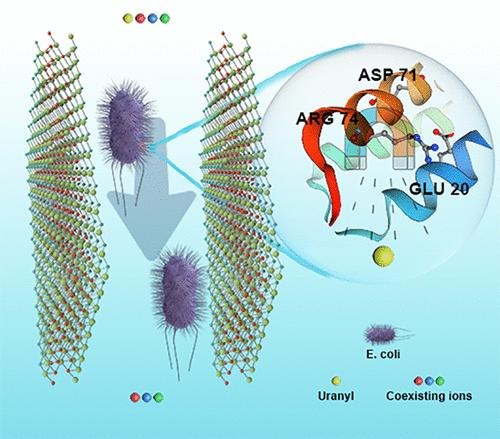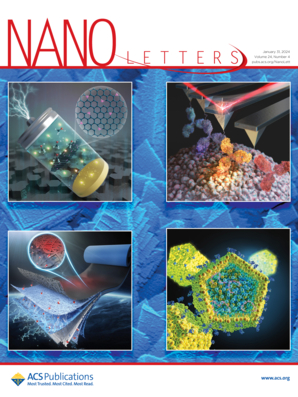层状生物无机 MXene 膜:利用转基因大肠杆菌从海水中提取铀的绿色方法
IF 9.6
1区 材料科学
Q1 CHEMISTRY, MULTIDISCIPLINARY
引用次数: 0
摘要
随着清洁能源需求的不断增长,需要高效的铀提取技术,尤其是从铀储量巨大的海水中提取铀。在这里,我们通过在二维(2D)MXene(Ti3C2Tx)层中植入超级铀酰结合蛋白(SUP)的大肠杆菌,开发出了一种复合膜。SUP 赋予了生物无机杂化膜对铀离子的超高选择性,而工程化大肠杆菌则提高了膜的机械强度和经济性。实验结果表明,该膜实现了对铀酰离子的精确识别和优异的离子筛选性能(SFU/V ≈ 43,SFNa/U ≈ 158)。出色的分离性能和循环稳定性测试证明了该膜的工业应用潜力。该方法提供了一种绿色和可持续的解决方案,将生物工程与纳米材料创新相结合,为从海水中提取铀提供了一种环境友好且高效的方法,标志着清洁能源资源开发领域的重大进展。本文章由计算机程序翻译,如有差异,请以英文原文为准。

Layered Bio-Inorganic MXene Membranes: A Green Approach for Uranium Extraction from Seawater Using Genetically Modified E. coli
With the growing demand for clean energy, efficient uranium extraction technologies are needed, especially from seawater, where uranium reserves are huge. Here, we developed a composite membrane by inserting Escherichia coli engineered with super uranyl-binding protein (SUP) within a two-dimensional (2D) MXene (Ti3C2Tx) layer. SUP endowed the bioinorganic hybrid membrane with ultrahigh selectivity for uranyl ions, while the engineered E. coli improved the mechanical strength and economy of the membranes. Experimental results showed that the membranes achieved precise recognition of uranyl ions and excellent ion screening performance (SFU/V ≈ 43, SFNa/U ≈ 158). Excellent separation performance and cyclic stability tests demonstrated the industrial application potential of the membrane. This method offers a green and sustainable solution, combining biological engineering and nanomaterial innovation, providing an environmentally friendly and efficient approach for uranium extraction from seawater, marking a significant advancement in the field of clean energy resource development.
求助全文
通过发布文献求助,成功后即可免费获取论文全文。
去求助
来源期刊

Nano Letters
工程技术-材料科学:综合
CiteScore
16.80
自引率
2.80%
发文量
1182
审稿时长
1.4 months
期刊介绍:
Nano Letters serves as a dynamic platform for promptly disseminating original results in fundamental, applied, and emerging research across all facets of nanoscience and nanotechnology. A pivotal criterion for inclusion within Nano Letters is the convergence of at least two different areas or disciplines, ensuring a rich interdisciplinary scope. The journal is dedicated to fostering exploration in diverse areas, including:
- Experimental and theoretical findings on physical, chemical, and biological phenomena at the nanoscale
- Synthesis, characterization, and processing of organic, inorganic, polymer, and hybrid nanomaterials through physical, chemical, and biological methodologies
- Modeling and simulation of synthetic, assembly, and interaction processes
- Realization of integrated nanostructures and nano-engineered devices exhibiting advanced performance
- Applications of nanoscale materials in living and environmental systems
Nano Letters is committed to advancing and showcasing groundbreaking research that intersects various domains, fostering innovation and collaboration in the ever-evolving field of nanoscience and nanotechnology.
 求助内容:
求助内容: 应助结果提醒方式:
应助结果提醒方式:


